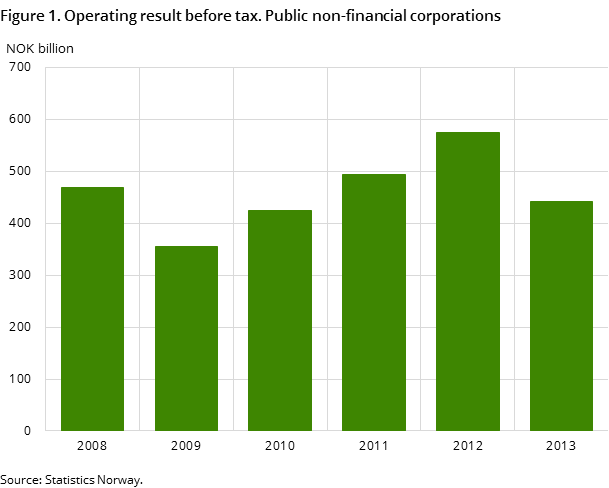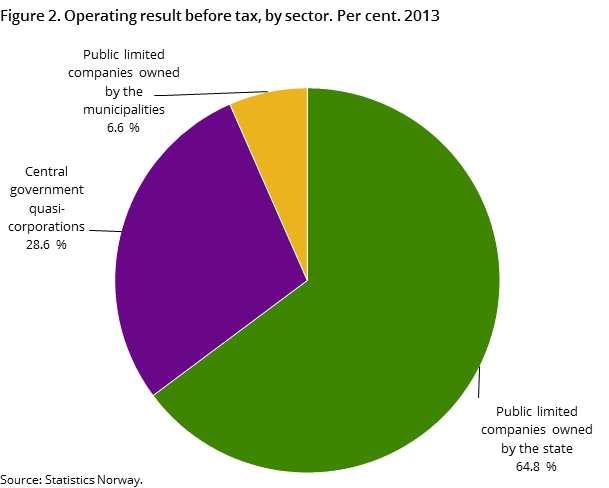Content
Published:
This is an archived release.
Oil and gas still largest contributor despite decrease
Public non-financial corporations had lower profits in 2013 than in 2012. The main contributor continues to be enterprises involved in mining and quarrying. Corporations involved in information and communication, electricity, gas, steam and air conditioning supply also contributed with just small changes for 2013 compared to 2012.
| 2013 | 2012 | 2011 | |
|---|---|---|---|
| Operating profit margin. Per cent | 23.89 | 24.92 | 23.98 |
| Operating margin. Per cent | 26.90 | 36.03 | 31.02 |
| Return on total assets. Per cent | 12.96 | 17.71 | 16.19 |
| Return on equity. Per cent | 10.29 | 18.17 | 15.85 |
| Equity ratio. Per cent | 45.09 | 45.65 | 42.44 |
| Current ratio | 1.00 | 0.87 | 0.88 |
| Ratio of fixed assets to long term capital | 1.00 | 1.04 | 1.04 |
| Debt-to-equity ratio | 1.22 | 1.19 | 1.36 |


Public non-financial corporations achieved some NOK 443 billion profit before tax in 2013. This is about 32 per cent of the operating income. The corresponding figures for 2012 were NOK 575 billion and 40 per cent respectively.
The decrease in profit is mainly a result of the reduction in profit in mining and quarrying. SDFI and Statoil ASA dominate this industry.
Operating results in electricity, gas, steam and air conditioning supply saw only minor changes compared to 2012.
The information and communication industry achieved a profit before tax of some NOK 36 billion and a net profit of just over NOK 32 billion. The transportation and storage industry realised profit before tax of some NOK 7 billion, and just below NOK 6.1 billion in net profit. The major corporations in this industry include Telenor ASA, Posten Norge AS and Norges Statsbaner AS.
Central government corporations with highest profit
Central government corporations and central government quasi-corporations together accounted for some 93.4 per cent of the total profit before tax or about NOK 414 billion. SDFI alone accounted for NOK 133 billion (the accounting figures are collected from Petoros AS Annual Accounting Report for 2013). Other major business units included Statoil ASA, Statkraft SF and Telenor ASA.
The local government enterprises achieved a profit of NOK 19.8 billion.
Increase in asset value
Public non-financial corporations’ total assets value amounted to some NOK 3 788 billion at the end of 2013. This was an increase of about NOK 762 billion from the previous year. The value of the fixed assets increased by 33.1 per cent, while the value of the current assets relating to sales of goods and services decreased by 3.7 per cent.
However, most of the capital is located in a small number of companies. Approximately 50 corporations contributed more than three quarters of the total assets. Each of these corporations has an asset value of more than NOK 8 billion. Eighteen of these capital-intensive enterprises are owned by local government and half of these are located in the electricity, gas, steam and air conditioning supply industry.
The financial situation
Public non-financial corporations had a relatively stable financial structure in the period 2008 to 2013. The equity ratio was about 45 per cent in 2013.
Furthermore, the ratio of fixed assets to long-term capital has been relatively stable and was around 1 during the period. In other words, fixed assets have been financed by long-term capital. The debt-equity ratio has been relatively stable.
The current ratio increased from 0.87 in 2012 to 1.00 in 2013. This means that the current assets are lower than the current liabilities. The figures do not necessarily illustrate the enterprises’ liquidity and therefore require careful consideration.
Central government quasi-corporations have been excluded here because the equity in these corporations cannot be compared with other public corporations.
Public ownershipOpen and readClose
Both the central and the local government have a significant ownership interest in Norwegian business and industry. The public companies vary with regard to economic activity. The level of ownership varies from holdings in large listed corporations to small fully-owned enterprises. The corporations are involved in activities such as mining and quarrying, energy supply, transport, real estate operations and rehabilitation. Mining and quarrying is the dominating business area and includes the State’s Direct Finance Investment (SDFI) and Statoil ASA among others. Corporations in the transportation and storage industry are the largest employers. These industries include Posten Norge AS and Norges Statsbaner AS.
DevelopmentOpen and readClose
All in all, Statistics Norway was able to obtain accounting data for 2013 on just over 3 050 public non-financial corporations. In addition, Statistics Norway was unable to obtain accounting data for just over 100 public corporations. The changes can be attributed to several reasons.
Central and local governments are mainly engaged in the following types of corporations:
-Private limited companies and public limited companies, including public corporations.
-Central and local government market entities, so-called quasi-corporations.
-Companies incorporated by special legislation.
Some central government and local government business units are also reclassified as management. As this continues from one year to another, many public corporations may be reclassified and as a result no longer be included in the statistics for the public non-financial corporations.
The statistics include all market non-financial corporations in which either the central government or municipalities/county municipalities directly or indirectly own more than 50 per cent of the shares. These include all companies incorporated by special legislation as well as central government market entities.
Contact
-
Francis Kwamena Acquah
E-mail: francis.kwamena.acquah@ssb.no
tel.: (+47) 40 90 26 62
